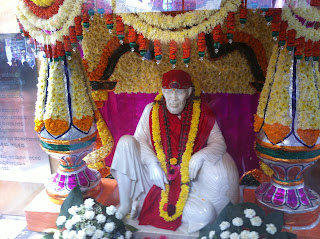The Deccan during the Medeival times!

Om Sai Ram. I am verily ignorant. I am a dullard and I do not claim to know the know the ways of the universe. If I do something and if I get to know a little, it is only because of my Satchitananda Sadguru Shree Sai Baba of Shirdi. Blessed are those who have sought refuge in him, for as he has promised, he will ferry us across the wicked ocean of Samsara(life,to be particular life of bondage). Just chanting "Sai,Sai" will give one infinite bliss and peace of mind. I therefore submit my ego at the lotus feet of my Sadguru, who is parbrahma and seek his blessings in describing his glory. For nothing brings one more happiness than singing his glory.
The Deccan had become a harsh place. There was the mighty Devagiri fort built by the mighty Yadava kings of Karnataka, protecting the local populace from outside invasion. Unfortunately, there was decline in the society. The twice born had become corrupt. There was unrighteousness in the place. It was during this time that Lord Jnaneshwar also known as Lord Jnanadeva was born in Alandi. Nivritthinath,Jnanadev,Muktabai and Sopan were the four brother and sister saints born to a Sanyasi. Just as Jesus Christ of Nazareth was born of a Virgin mother, these four great incarnations of Parabrahman were born as children of a Sanyasin. The society gave them and their parents nothing but trouble. And yet, to the society they did infinite good. In his brief physical existance, Lord Jnanadev spread bhakthi, righteousness and courage amongst the local populace. He started the Varis or the Varkari Sampradaya (tradition) - Yearly travel to Pandharpur. He also wrote his treatise on the Gita, called Jnaneshwari, which became called as the common man's Gita. It is sweeter than nectar and most poetic in essance.
At the same time as Lord Jnanadev, there came other Saints,Sadguru's and incarnations such as Namadev - the great devotee of Vitthala at Pandarapur,Kabir - the weaver,Tukaram,Ghora the potter,Nnarahari the gardner, Janabai, Bhanudas, Eknath,Shreepadha Shree Vallabha,Shree Narasimha Saraswathi, Shree Samarth Ramdas, Shree Swami Samarth. Shri Sai Baba of Shirdi is one with all these avataras. He was one amongst a long line of saints who came to the deccan and were like a powerful beacon of hope to the local populace.
India is a beautiful country. Here there are people belonging to several religions living together. Before Lord Sainath came to Shirdi, the Muslim invasion of the Deccan had happened sometime in the 13th century AD. After some upheaval, there were times when the cultural divide went away. The new converts to Islam also worshipped Lord Dattatreya for the sake of material gains. The followers of Sanathana Dharma also respected the Sufi saints, whose devotion to God and peace seemed almost Upanishadic (The way of the Upanishads.) The peak of religious tolerance was observed when the Bahamani king, Allauddin the second came to power. He worshipped Lord Dattatreya by worshipping the lotus feet of Lord Dattatreya incarnate, Shree Narasimha Saraswathi.
Also, when one observes the way of the saints of the Deccan, one finds music to be an essential form of worship. The Marathi abhangas became very popular in the Deccan, as did Karnatic music with the Dasa Koota at Karnataka. Even the aarthi (Weaving of lighted lamps before God), is often accompanied by music. There is a reason behind this. It is often speculated that, during the reign of the Bahamani's in south India, around a thousand Sufi saints came to India, for the sake of showing people the way of Islam in a peaceful way. Their dedication to god, accompanied by the singing of his name, with music, was most captivating. The Quwalli, was also born this way. To counter this, or rather influenced by this, the followers of Sanathana dharma also started the bhakthi movement (the path of devotion). The aarthi's sung were accompanied by the music of cymbals and drums. Beautiful abhangas were written describing the glory of God.
Thus did the Deccan experience an evolution during the turbulent Medeival times, which resulted in the appearence of many Saints, Sadguru's and divine incarnations who quenched the parched minds of the poor and troubled people and provided them respite and hope and salvation. I now bow before all these saints and beseech the Parabrahma who came in their form to bless me to be always his servent and to always sing his glory and to never swerve from the righteous path. In the next blog, I will describe the advent of Lord Sainath in Shirdi and the experiences of people who first laid eyes on him in Shirdi.
Bow to Shri Sai! Peace be to all!



Comments